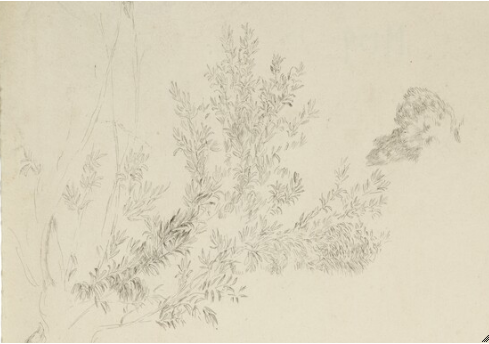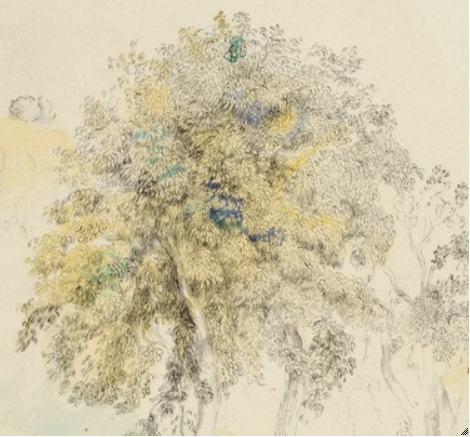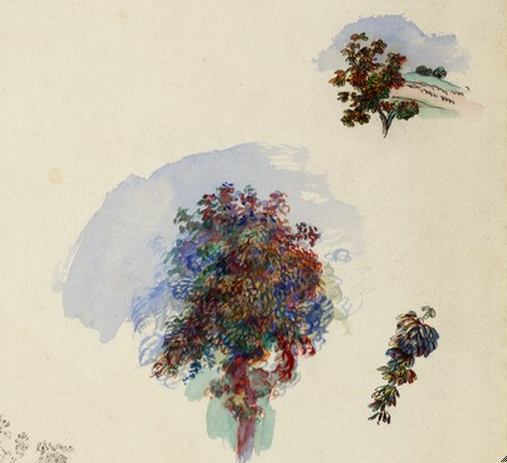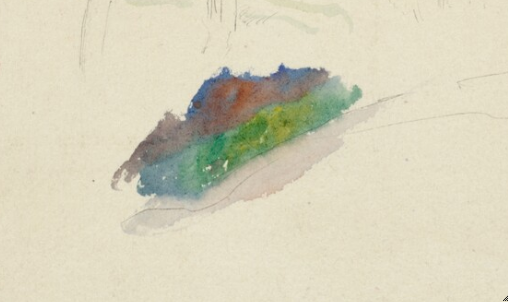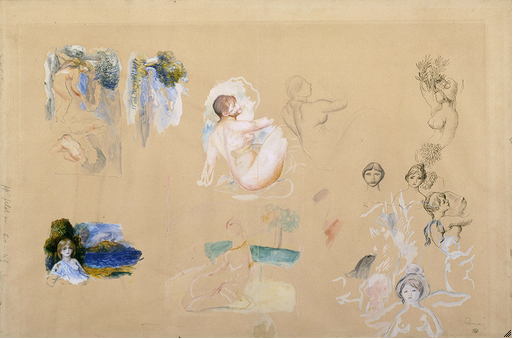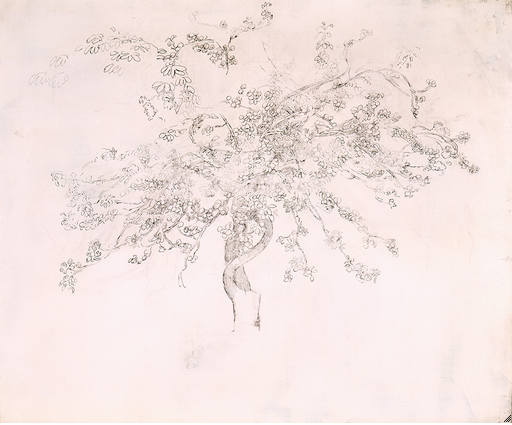Cat. 20
Studies of Trees and Foliage
1884/87
Pen and black ink, with opaque and transparent watercolor, on ivory wove paper; 497 × 309 mm
The Art Institute of Chicago, gift of Mrs. Potter Palmer, 1948.75
The small clusters of detail on this sheet, which the artist developed to different degrees of completion, may have been produced on separate occasions. The delicate draftsmanship of the group in the upper left, for instance, contrasts markedly with the freer, brightly colored areas at center right and right.
It was common for Renoir to work on a single page intermittently. An example of this is his Study of an Iris and a Tree (1883/85; collection of Mrs. G. B. Springwell, in which the motifs are quite distinct from one another. It is possible that this working method helped him to hone his ideas (as had been the case in his Sheet of Studies [fig. 1.4] [Dauberville 1621] for The Great Bathers). However, since the Art Institute’s sheet bears no strong connection to a more substantial work, it may have been a playful exercise that served no serious purpose.
Contrasts in style and handling across the page might even suggest that, in addition to drawing the respective clusters at different moments, Renoir revisited some of them repeatedly. For instance, if the small looped lines he used to sketch the trees at the lower left of the page resemble the marks he made in his Study of a Tree (fig. 6.14), the faint yellow wash and touches of brighter blue and green convey a different mood. Perhaps they belong to a later moment. They are casual, as are the red and purple dots he added to their lower right.
Renoir applied color directly to the largest painted area in this work. He established the contours of the foliage in blue, perhaps mindful of his friend Paul Cézanne, who used this strategy often in his painting. The artists had worked together in the south of France in the mid-1880s. Certainly, the tonality here is Mediterranean in feel; against a fresh blue background, warm reds and oranges enliven the more predictable touches of green.
Nancy Ireson
Technical Report
Technical Summary
In Studies of Trees and Foliage, Renoir created five individual studies in pen and black ink and watercolor, distributing them fairly evenly apart on the moderately thick, ivory [glossary:wove] paper. The studies were executed with a similar handling and style, but they range in development. Opaque (gouache) and transparent watercolors were applied by brush to varying degrees in the four studies in the lower half of the sheet. The study in the upper left quadrant was drawn directly in pen and black ink (fig. 1.2), whereas the study just below it, in the lower left quadrant, was rendered more realistically, with broad applications of transparent yellow [glossary:wash] and touches of blue watercolor over the pen and ink (fig. 1.1). At center bottom, there is a small area of brightly colored watercolor washes that may be initial attempts at rendering the landscape or perhaps a purely technical exploration (fig. 1.3).
In contrast to the more direct work in pen and ink on the left side, Renoir created three richly decorative studies at the center right side of the sheet by layering transparent and opaque watercolor with a fine brush (fig. 5.11). The two smallest studies were created by applying watercolor over the pen and black ink lines, whereas the largest was created entirely in watercolor by laying down lines of red and blue watercolor and small dabs of varying colors.
Media and Support
Support Characteristics
Primary paper type
Ivory, moderately thick, moderately textured wove paper.
Furnish
Uniform, without significant inclusions or colored fibers.
Formation
Even, machine made.
Other characteristics
[glossary:Deckle edges] are present along the left, top, and bottom edges; the right edge is trimmed straight.
Dimensions
497 × 309 mm
Preparatory Layers
No artistic surface alterations or coatings are visible under normal conditions or under magnification. Under ultraviolet ([glossary:UV]) illumination, there is a pale-yellow visible-light [glossary:fluorescence] overall on the paper surface that is characteristic of a light gelatin surface [glossary:sizing]; the fluorescence is most pronounced around the perimeter of the paper sheet where the window mat protected it from exposure to light.
Media Characteristics
Pen and black ink was used to lay out four of the five compositional studies. The study at the upper left was created entirely in pen and black ink. Opaque (gouache) and transparent watercolors were used to varying degrees in the remaining four studies in the lower half of the sheet. Watercolor was applied over pen and brush in three of these studies, whereas the largest study at the center right side was executed entirely in watercolor.
There is no drawing on the verso.
Compositional Development
No revisions or changes to the composition are visible under normal conditions or magnification other than intended experimentation with coloring.
Surface Treatment
Artist’s fixative/other
No artistic surface fixatives or coatings are visible under normal conditions, UV illumination, or magnification.
Condition History
The drawing exhibits light discoloration overall that is darkest at the edges. Surface soiling and light handling dents appear around the perimeter due to general handling of the sheet. The edges are particularly soiled, and the lower right edge is irregularly formed and slightly indented. A small indentation is visible in the support surface at lower left. In the upper right area, there is a yellowish-brown stain that is approximately .02 cm in diameter.
On the verso, there are three areas of residual material or adhesive along the right edge that slightly absorb UV radiation and likely relate to former hinging spots. There are undulations along the left edge that also likely relate to former hinging.
Kimberly Nichols
Provenance
Ambroise Vollard (1866–1939), Paris.
Fraysse collection, Paris, by 1938.
Sold by Durlacher Brothers, New York, to Philip Hofer (1898–1984), Cambridge, Mass., Nov. 28, 1938.
Consigned by Phillip Hofer to Durlacher Brothers, New York, Oct. 1947.
Sold by Durlacher Brothers, New York, to the Art Institute of Chicago, 1948.
Exhibition History
Paris, Galeries Durand-Ruel, Aquarelles, pastels et dessins par Renoir, Apr. 4–23, 1921, cat. 16.
Cambridge, Mass., Fogg Museum, Harvard Art Museums, 1944–1947.
Santa Barbara (Calif.) Museum of Art, Painted Papers: Watercolors from Dürer to the Present, Mar. 15–Apr. 15, 1962, cat. 69.
Paris, Musée du Louvre, Dessins français de l’Art Institute de Chicago de Watteau à Picasso, Oct. 15, 1976–Jan. 17, 1977, cat. 69 (ill.).
Frankfurt am Main, Germany, Städtische Galerie im Städelschen Kunstinstitut, Französische Zeichnungen aus dem Art Institute of Chicago, Feb. 10–Apr. 10, 1977, cat. 62 (ill.).
Tokyo, Isetan Museum of Art, Exposition Renoir, Sept. 26–Nov. 6, 1979, cat. 91 (ill.); and the Kyoto Municipal Museum, Nov. 10–Dec. 9, 1979.
Selected References
John Rewald, Renoir Drawings (H. Bittner, 1946), p. 21, no. 50 (ill.).
Harold Joachim and Sandra Haller Olsen, French Drawings and Sketchbooks of the Nineteenth Century, vol. 2 (University of Chicago Press, 1979), p. 92, no. 5D11.
Douglas W. Druick, Renoir, Artists in Focus (Art Institute of Chicago/Abrams, 1997), pp. 71, 91, 111, no. 18 (ill.).
Guy-Patrice Dauberville and Michel Dauberville, Renoir: Catalogue raisonné des tableaux, pastels, dessins et aquarelles, vol. 2, 1882–1894 (Bernheim-Jeune, 2009), p. 579, no. 1630 (ill.).
Other Documentation
Inscriptions and Distinguishing Marks
Recto
Inscription
Location: lower right corner
Method: [glossary:graphite]
Content: 132- (?) [partially erased]
Verso
Inscription
Location: upper right corner
Method: stamped in pale red ink
Content: Douanes Exposition Paris
Mark
Location: center left
Method: graphite
Content: No 130
Mark
Location: upper center area
Method: graphite
Content: M129
Examination Conditions and Technical Analysis
Raking Visible Light
Paper [glossary:support] characteristics identified.
Transmitted Visible Light
Paper mold characteristics identified.
Ultraviolet-Induced Visible Fluorescence (365 nm)
Light surface sizing detected, most visible at the perimeter.
Binocular microscopy (80–100×)
Media identified.
Image Inventory
The image inventory compiles records of all known images of the artwork on file in the Imaging Department and in the conservation and curatorial files in the Department of Prints and Drawings at the Art Institute of Chicago (fig. 5.12).

